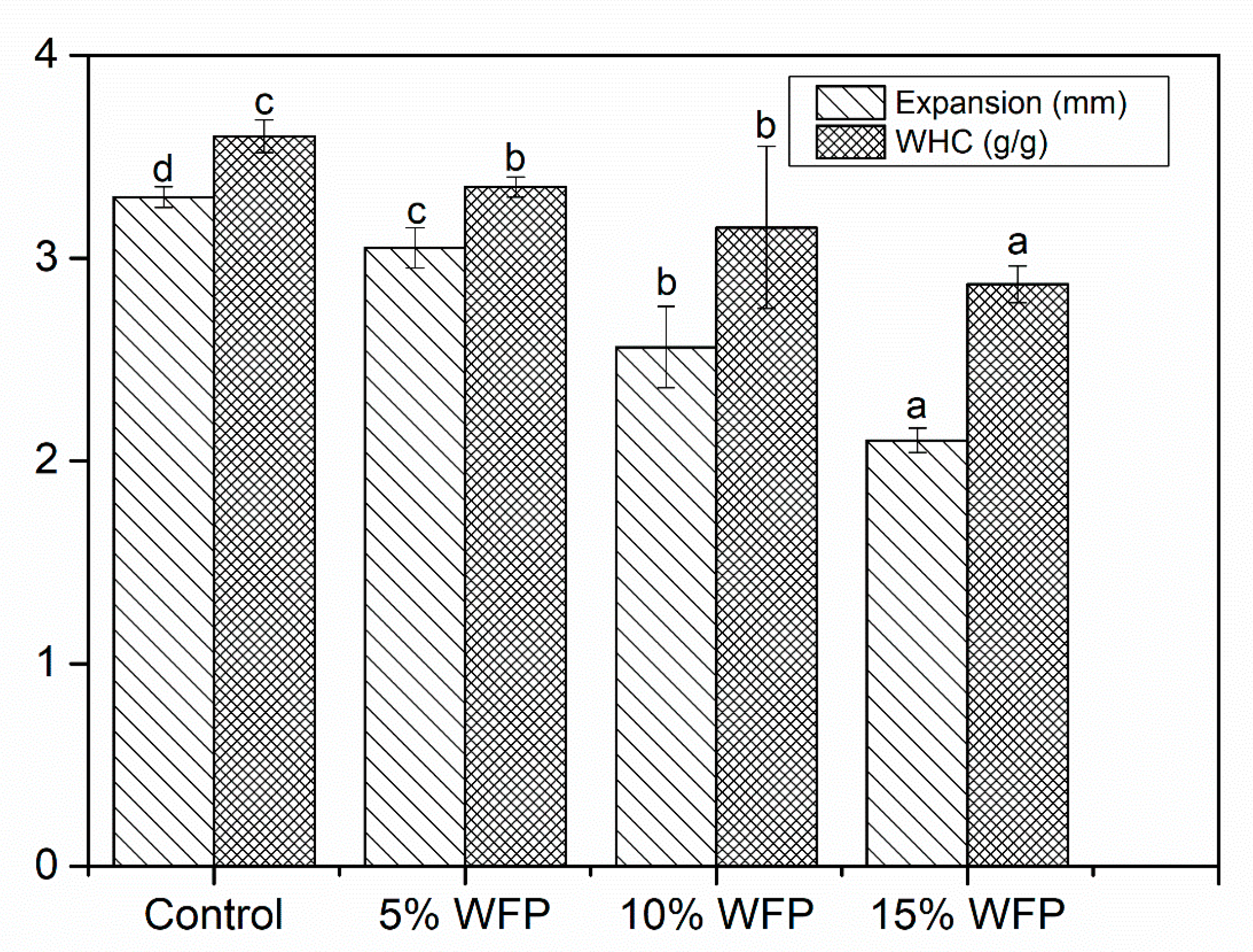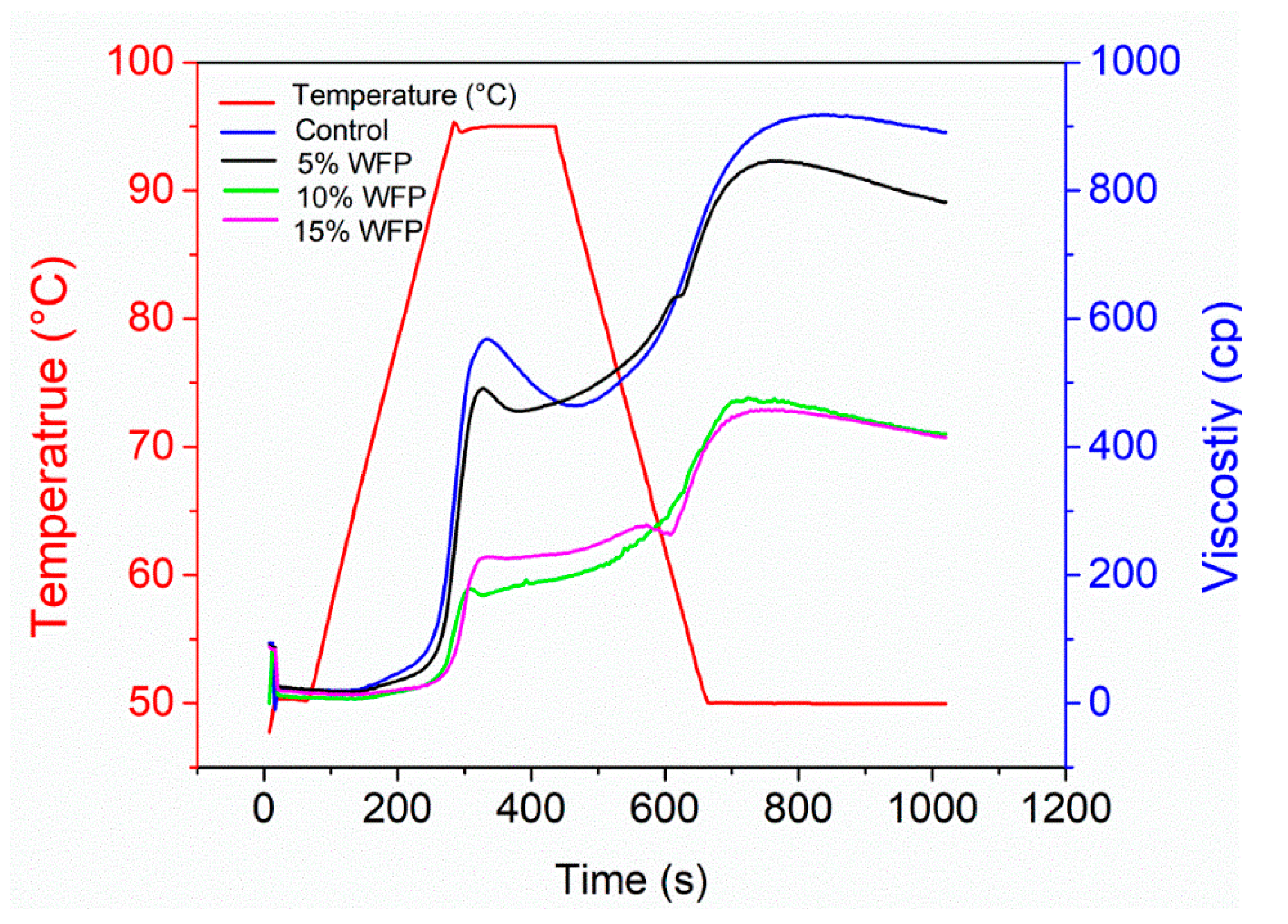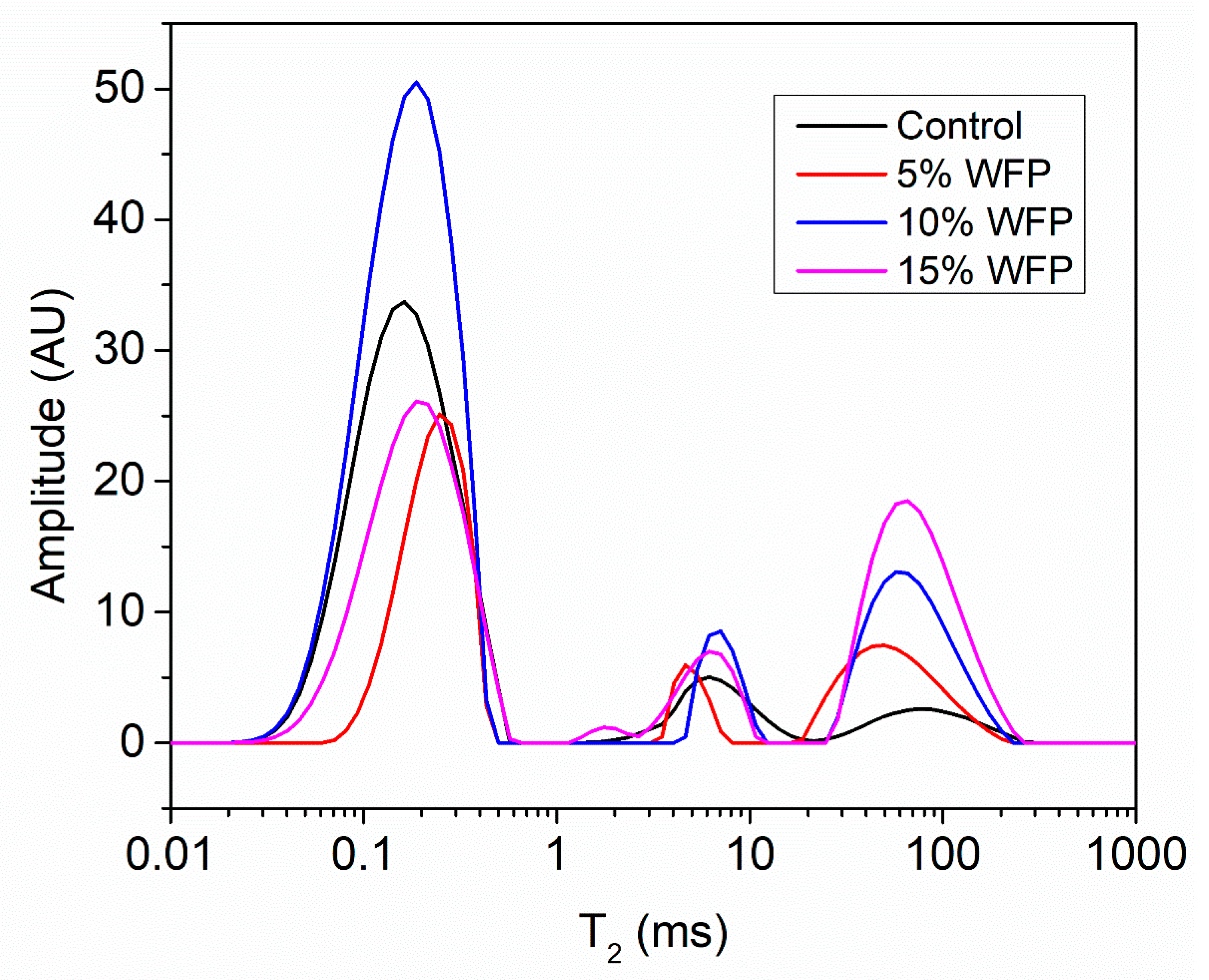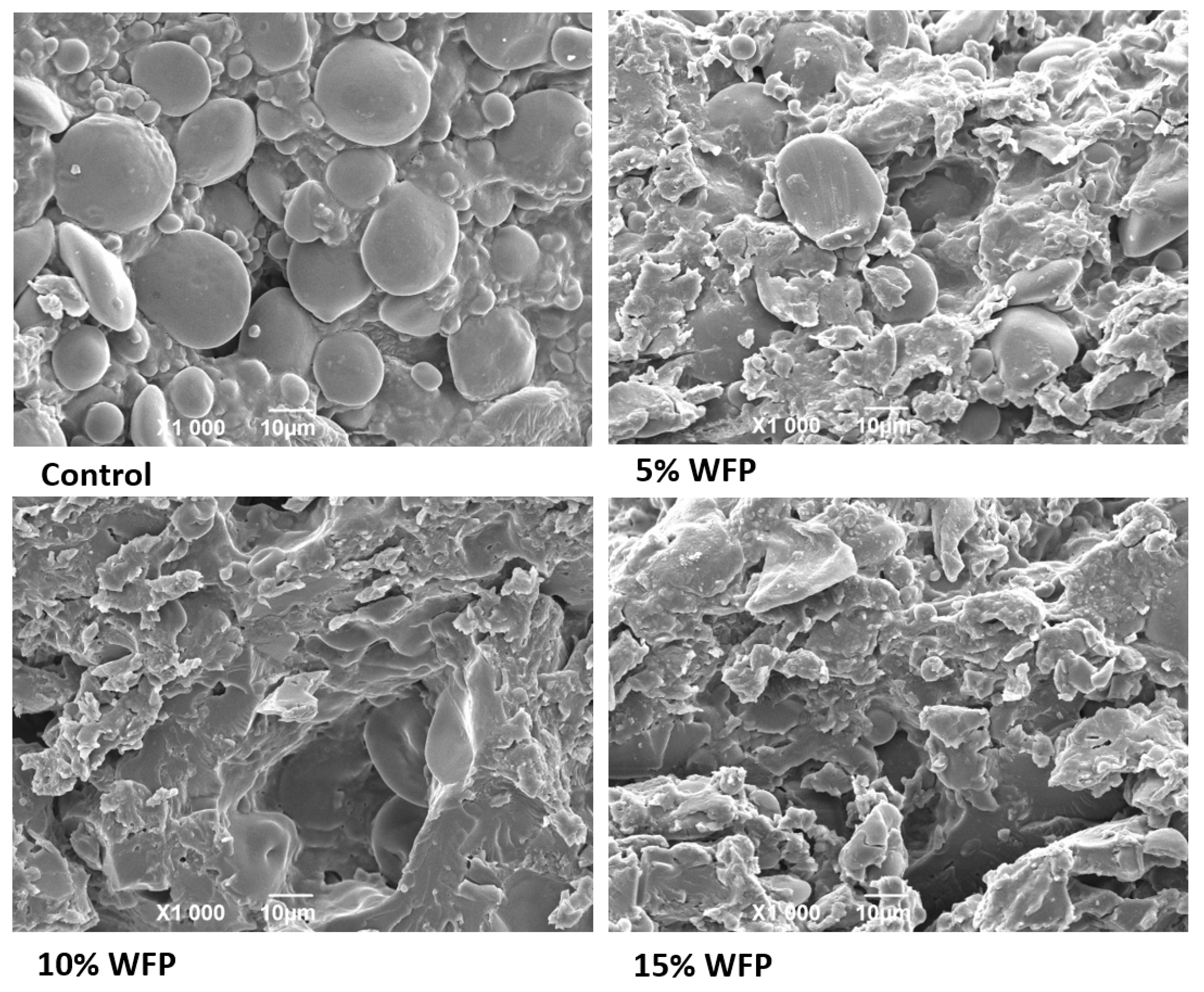Whole Fish Powder Snacks: Evaluation of Structural, Textural, Pasting, and Water Distribution Properties
Abstract
1. Introduction
2. Materials and Methods
2.1. Materials
2.2. Micro Size Whole Fish Powder
2.3. Preparation of Snacks
2.4. Expansion
2.5. Proximate Composition
2.6. Texture Profile Analysis
2.7. Color Analysis
2.8. Pasting Properties of Baked Snacks
2.9. Water Distribution/LF-NMR
2.10. Scanning Electron Microscopy (SEM) Analysis
2.11. Statistical Analysis
3. Results and Discussion
3.1. Expansion and Water Holding Capacity
3.2. Proximate Composition
3.3. Texture Profile Analysis
3.4. Color Parameters
3.5. Pasting Properties
3.6. LF-NMR Analysis
3.7. Microstructure
4. Conclusions
Author Contributions
Funding
Data Availability Statement
Acknowledgments
Conflicts of Interest
References
- FAO. State of World Fisheries and Aquaculture 2016 (French); Food & Agriculture Organization: Rome, Italy, 2016. [Google Scholar]
- Ishak, N.H.; Sarbon, N.M. A review of protein hydrolysates and bioactive peptides deriving from wastes generated by fish processing. Food Bioprocess Technol. 2018, 11, 2–16. [Google Scholar] [CrossRef]
- Khalili Tilami, S.; Sampels, S. Nutritional value of fish: Lipids, proteins, vitamins, and minerals. Rev. Fish. Sci. Aquac. 2018, 26, 243–253. [Google Scholar] [CrossRef]
- Mittendorfer, B.; Klein, S.; Fontana, L. A word of caution against excessive protein intake. Nat. Rev. Endocrinol. 2020, 16, 59–66. [Google Scholar] [CrossRef] [PubMed]
- Nawaz, A.; Li, E.; Irshad, S.; Xiong, Z.; Xiong, H.; Shahbaz, H.M.; Siddique, F. Valorization of fisheries by-products: Challenges and technical concerns to food industry. Trends Food Sci. Technol. 2020, 99, 34–43. [Google Scholar] [CrossRef]
- Olsen, R.L.; Toppe, J.; Karunasagar, I. Challenges and realistic opportunities in the use of by-products from processing of fish and shellfish. Trends Food Sci. Technol. 2014, 36, 144–151. [Google Scholar] [CrossRef]
- Reddy, V.; Urooj, A.; Kumar, A. Evaluation of antioxidant activity of some plant extracts and their application in biscuits. Food Chem. 2005, 90, 317–321. [Google Scholar] [CrossRef]
- Ndiritu, A.K.; Kinyuru, J.N.; Kenji, G.M.; Gichuhi, P.N. Extraction technique influences the physico-chemical characteristics and functional properties of edible crickets (Acheta domesticus) protein concentrate. J. Food Meas. Charact. 2017, 11, 2013–2021. [Google Scholar] [CrossRef]
- Nawaz, A.; Xiong, Z.; Li, Q.; Xiong, H.; Irshad, S.; Chen, L.; Wang, P.; Zhang, M.; Hina, S.; Regenstein, J.M. Evaluation of physicochemical, textural and sensory quality characteristics of red fish meat-based fried snacks. J. Sci. Food Agric. 2019, 99, 5771–5777. [Google Scholar] [CrossRef] [PubMed]
- Nawaz, A.; Xiong, Z.; Xiong, H.; Chen, L.; Wang, P.-k.; Ahmad, I.; Hu, C.; Irshad, S.; Ali, S.W. The effects of fish meat and fish bone addition on nutritional value, texture and microstructure of optimised fried snacks. Int. J. Food Sci. Technol. 2019, 54, 1045–1053. [Google Scholar] [CrossRef]
- Nawaz, A.; Xiong, Z.; Li, Q.; Xiong, H.; Liu, J.; Chen, L.; Wang, P.; Walayat, N.; Irshad, S.; Regenstein, J.M. Effect of wheat flour replacement with potato powder on dough rheology, physiochemical and microstructural properties of instant noodles. J. Food Process. Preserv. 2019, 43, e13995. [Google Scholar] [CrossRef]
- Shah Mohammadi, H.R.; Bakar, J.; Russly, A.R.; Noranizan, M.A.; Mirhosseini, H. Puffed Corn-Fish Snack Development by Extrusion Technology. Iran. J. Fish. Sci. 2014, 13, 748–760. [Google Scholar]
- Desai, A.; Brennan, M.A.; Brennan, C.S. The effect of semolina replacement with protein powder from fish (Pseudophycis bachus) on the physicochemical characteristics of pasta. LWT 2018, 89, 52–57. [Google Scholar] [CrossRef]
- Abbey, L.; Glover-Amengor, M.; Atikpo, M.O.; Atter, A.; Toppe, J. Nutrient content of fish powder from low value fish and fish byproducts. Food Sci. Nutr. 2017, 5, 374–379. [Google Scholar] [CrossRef] [PubMed]
- Larsen, T.; Thilsted, S.H.; Kongsbak, K.; Hansen, M. Whole small fish as a rich calcium source. Br. J. Nutr. 2000, 83, 191–196. [Google Scholar] [CrossRef] [PubMed]
- El-Beltagi, H.S.; El-Senousi, N.A.; Ali, Z.A.; Omran, A.A. The impact of using chickpea flour and dried carp fish powder on pizza quality. PLoS ONE 2017, 12, e0183657. [Google Scholar] [CrossRef]
- Nawaz, A.; Xiong, Z.; Xiong, H.; Irshad, S.; Chen, L.; Wang, P.-k.; Ahsan, H.M.; Walayat, N.; Qamar, S.H. The impact of hydrophilic emulsifiers on the physico-chemical properties, microstructure, water distribution and in vitro digestibility of proteins in fried snacks based on fish meat. Food Funct. 2019, 10, 6927–6935. [Google Scholar] [CrossRef] [PubMed]
- Nawaz, A.; Ali, S.W.; Irshad, S.; Irshad, F.; Ahmed, A.; Sharmeen, Z.; Khan, I. Effect of peeling and unpeeling on yield, chemical structure, morphology and pasting properties of starch extracted from three diverse potato cultivars of Pakistan. Int. J. Food Sci. Technol. 2019. [Google Scholar] [CrossRef]
- Walayat, N.; Xiong, Z.; Xiong, H.; Moreno, H.M.; Niaz, N.; Ahmad, M.N.; Hassan, A.; Nawaz, A.; Ahmad, I.; Wang, P.-K. Cryoprotective effect of egg white proteins and xylooligosaccharides mixture on oxidative and structural changes in myofibrillar proteins of Culter alburnus during frozen storage. Int. J. Biol. Macromol. 2020, 158, 865–874. [Google Scholar] [CrossRef]
- Allen, K.E.; Carpenter, C.E.; Walsh, M.K. Influence of protein level and starch type on an extrusion-expanded whey product. Int. J. Food Sci. Technol. 2007, 42, 953–960. [Google Scholar] [CrossRef]
- Singh, B.; Rachna; Hussain, S.Z.; Sharma, S. Response Surface Analysis and Process Optimization of Twin Screw Extrusion Cooking of Potato-Based Snacks. J. Food Process. Preserv. 2015, 39, 270–281. [Google Scholar] [CrossRef]
- Anton, A.A.; Fulcher, R.G.; Arntfield, S.D. Physical and nutritional impact of fortification of corn starch-based extruded snacks with common bean (Phaseolus vulgaris L.) flour: Effects of bean addition and extrusion cooking. Food Chem. 2009, 113, 989–996. [Google Scholar] [CrossRef]
- Yang, C.; Zhong, F.; Douglas Goff, H.; Li, Y. Study on starch-protein interactions and their effects on physicochemical and digestible properties of the blends. Food Chem. 2019, 280, 51–58. [Google Scholar] [CrossRef]
- Liu, T.; Hamid, N.; Kantono, K.; Pereira, L.; Farouk, M.M.; Knowles, S.O. Effects of meat addition on pasta structure, nutrition and in vitro digestibility. Food Chem. 2016, 213, 108–114. [Google Scholar] [CrossRef] [PubMed]
- Abdel-Moemin, A.R. Healthy cookies from cooked fish bones. Food Biosci. 2015, 12, 114–121. [Google Scholar] [CrossRef]
- Nawaz, A.; Li, E.; Khalifa, I.; Irshad, S.; Walayat, N.; Mohammed, H.H.H.; Zhang, Z.; Ahmed, S.; Simirgiotis, M.J. Evaluation of fish meat noodles: Physical property, dough rheology, chemistry and water distribution properties. Int. J. Food Sci. Tech. 2021, 56, 1061–1069. [Google Scholar] [CrossRef]
- Walayat, N.; Xiong, Z.; Xiong, H.; Moreno, H.M.; Li, Q.; Nawaz, A.; Zhang, Z.; Wang, P.; Niaz, N. The effectiveness of egg white protein and β-cyclodextrin during frozen storage: Functional, rheological and structural changes in the myofibrillar proteins of Culter alburnus. Food Hydrocoll. 2020, 105, 105842. [Google Scholar] [CrossRef]
- Phuhongsung, P.; Zhang, M.; Devahastin, S. Investigation on 3D printing ability of soybean protein isolate gels and correlations with their rheological and textural properties via LF-NMR spectroscopic characteristics. LWT 2020, 122, 109019. [Google Scholar] [CrossRef]
- Li, C.; Liu, D.; Zhou, G.; Xu, X.; Qi, J.; Shi, P.; Xia, T. Meat quality and cooking attributes of thawed pork with different low field NMR T21. Meat Sci. 2012, 92, 79–83. [Google Scholar] [CrossRef]
- Walayat, N.; Xiong, Z.; Xiong, H.; Moreno, H.M.; Nawaz, A.; Niaz, N.; Hu, C.; Taj, M.I.; Mushtaq, B.S.; Khalifa, I. The effect of egg white protein and β-cyclodextrin mixture on structural and functional properties of silver carp myofibrillar proteins during frozen storage. LWT 2021, 135, 109975. [Google Scholar] [CrossRef]




| Samples | Control | 5% WFP | 10%WFP | 15%WFP |
|---|---|---|---|---|
| Moisture (%) | 9.32 ± 1.04 a* | 10.85 ± 0.34 b | 11.85 ± 0.64 c | 12.32 ± 1.23 c |
| Fat (%) | 1.45 ± 0.14 a | 1.95 ± 0.44 b | 2.35 ± 0.14 c | 3.54 ± 0.21 d |
| Ash (%) | 0.94 ± 0.32 a | 2.43 ± 1.04 b | 5.65 ± 1.11 c | 7.86 ± 0.78 d |
| Protein (%) | 11.25 ± 1.76 a | 14.23 ± 0.04 b | 17.11 ± 0.04 c | 19.56 ± 0.04 d |
| Carbohydrates (%) | 78.49 ± 1.02 d | 70.54 ± 2.64 c | 63.25 ± 3.58 b | 56.76 ± 1.54 a |
| L * | 89.75 ± 0.53 d | 86.77 ± 0.23 c | 81.52 ± 1.23 b | 80.86 ± 0.33 a |
| a * | 0.89 ± 0.04 a | 1.50 ± 0.14 b | 1.96 ± 0.23 c | 2.40 ± 0.17 d |
| b * | 13.20 ± 0.84 a | 16.70 ± 0.34 b | 17.70 ± 0.44 c | 18.59 ± 0.74 c |
| TPA (N) | 40.52 ± 2.30a | 44.55 ± 1.30 b | 46.32 ± 2.70 c | 47.32 ± 2.90 c |
| Samples | Peak Viscosity (RVU) | Trough Viscosity (RVU) | Breakdown Viscosity (RVU) | Final Viscosity (RVU) | Setback (RVU) | Temperature (°C) |
|---|---|---|---|---|---|---|
| Control | 568 ± 23.34 d | 464 ± 06.75 c | 104 ± 16.89 b* | 891 ± 53.37 d | 427 ± 41.68 d | 91.35 ± 0.31 a |
| 5% WFP | 491 ± 43.22 c | 456 ± 13.37 c | 25 ± 10.63 a | 782 ± 26.63 b | 316 ± 13.82 c | 92.85 ± 0.13 b |
| 10%WFP | 192 ± 23.59 a | 180 ± 63.12 a | 12 ± 23.55 a | 420 ± 31.46 a | 228 ± 37.79 b | 95.25 ± 0.24 c |
| 15%WFP | 231 ± 26.78 b | 226 ± 16.31 b | 10 ± 13.91 a | 415 ± 26.71 a | 183 ± 15.83 a | 94.72 ± 0.47 c |
Publisher’s Note: MDPI stays neutral with regard to jurisdictional claims in published maps and institutional affiliations. |
© 2021 by the authors. Licensee MDPI, Basel, Switzerland. This article is an open access article distributed under the terms and conditions of the Creative Commons Attribution (CC BY) license (https://creativecommons.org/licenses/by/4.0/).
Share and Cite
Nawaz, A.; Khalifa, I.; Walayat, N.; Lorenzo, J.M.; Irshad, S.; Abdullah; Ahmed, S.; Simirgiotis, M.J.; Ali, M.; Li, E. Whole Fish Powder Snacks: Evaluation of Structural, Textural, Pasting, and Water Distribution Properties. Sustainability 2021, 13, 6010. https://doi.org/10.3390/su13116010
Nawaz A, Khalifa I, Walayat N, Lorenzo JM, Irshad S, Abdullah, Ahmed S, Simirgiotis MJ, Ali M, Li E. Whole Fish Powder Snacks: Evaluation of Structural, Textural, Pasting, and Water Distribution Properties. Sustainability. 2021; 13(11):6010. https://doi.org/10.3390/su13116010
Chicago/Turabian StyleNawaz, Asad, Ibrahim Khalifa, Noman Walayat, Jose M. Lorenzo, Sana Irshad, Abdullah, Shakeel Ahmed, Mario Juan Simirgiotis, Madad Ali, and Enpeng Li. 2021. "Whole Fish Powder Snacks: Evaluation of Structural, Textural, Pasting, and Water Distribution Properties" Sustainability 13, no. 11: 6010. https://doi.org/10.3390/su13116010
APA StyleNawaz, A., Khalifa, I., Walayat, N., Lorenzo, J. M., Irshad, S., Abdullah, Ahmed, S., Simirgiotis, M. J., Ali, M., & Li, E. (2021). Whole Fish Powder Snacks: Evaluation of Structural, Textural, Pasting, and Water Distribution Properties. Sustainability, 13(11), 6010. https://doi.org/10.3390/su13116010











